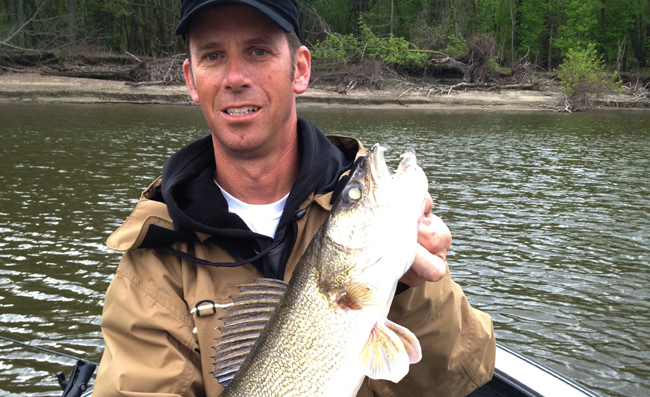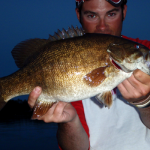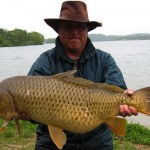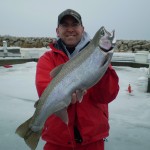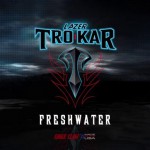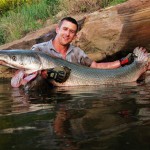By: Kenny Lookingbill – Date Posted: July 10, 2012
Advances in fishing technology have come a long way in the past 20 years. One of the more recent innovations in fishing are side scan sonars. The technology has actually been in existence for more than 60 years, and was first used in US submarines. Companies such as Lowrance and Hummingbird began to develop units with this technology to go along with bottom scan in the 1980’s, but it hasn’t been until the last decade that it has really taken hold of the fishing community.

I had read a lot about the technology, but was not exposed to side scan sonar until last spring while working with the Illinois Department of Natural Resources. We were checking gill nets for hybrid striped bass and I was amazed with the resolution on the screen and being able to see individual fish trapped in the net. The possibilities of applying this sonar technology to different styles of fishing began to captivate my imagination.
One day while fishing for walleye on the Mississippi River, my partner and I were fishing wing dams. The trolling bite was slow on the flats and we wanted to target larger fish that tend to congregate on the wing dams. For those of you who are not familiar with Mississippi River fishing, one of the major strategies, whether you are fishing walleye, largemouth bass, or channel catfish, is fishing wing dams. This form of fishing can be dangerous for boats and requires advanced boat control. While we were fishing, I suggested we start the kicker motor up and do a run parallel to the upstream side of the wing dam. What we saw on the screen opened up a whole new world for us. We ran along several wing dams and found a large variety of different structure including log jams, scour holes, even holes blown out of the wing dam. There were even fish being shown holding close to structure.

Finding out which wing dams hold fish and which do not is important for catching fish. Distinguishing good wing dams from bad holds extra importance to tournament situations, especially where the difference between a middle the pack finish and cashing a first place check is one kicker female on a wing dam. The pools of the Mississippi River have several wing dams to choose from and using this technology in pre fishing situations or even in tournaments on the fly can help pick out which wing dam to fish quickly for that money placing fish. Schools of baitfish can also be located with these units.

FLW and AIM walleye tournament pro and fellow Fishing-Headquarters contributor, Roy Vivian, frequently relies on his electronics for finding schools of walleyes relating to wing dams.
In May 2012, he recently fished the FLW Mississippi River out of Red Wing, MN. Knowing that most of the 110 boats were going to be fishing pool 4, he and his partner decided to try finding some productive wing dams on pool 3. Until this moment, he had never fished pool 3 and with over 100 wing dams within the tournament boundaries it was a bit intimidating.
According to Vivian, the river was at near record lows for that time of year and many of the wing dams were hard to see as there just wasn’t any current flowing over them. At the end of day 1 he caught a couple of fish in the 4-6 pound range. Both fish came on wing dams that had deep water in front of the dams, good current flowing over the dams, and each was the first wing dam of a series of wing dams.


Vivian thought he was onto something but wanted to make sure so he then relied on his Lund’s electronics. He used his Humminbird 1198SI in three key ways. First was using the mapping overlay which enabled him to identify the first two to three wing dams in a series knowing that the these dams were diverting the current out into the main channel and away from the wing dams below.
Next, he drove up to each wing dam and changed to a dual screen, one side with the regular sonar (quickfire) and one side with side imaging. If the water in front of the wing dam was less than 8 feet deep he continued on to the next wing dam. If the water was 8 feet deep or greater, the boat was maneuvered into the trough, the area just in front of the wing dam that is scoured out from the dam’s effect on the water. If the bottom of his sonar screen was yellow, indicating a silt bottom, he would move on to the next wing dam. Ifthe sonar screen was red then he would mark this wing dam with an icon due to good potential.

The third step Vivian took was to then view the wing dam with the side scan. He searched for any irregularities of the dam such as blow out holes, logs or trees wedged on the dam, areas with more rock than other areas, and anything that created an ambush spot for walleyes. When he saw something like an area in the dam where some of the rock had been blown out (big trees floating down river in floods can cause these), he immediately looked to the water and saw what the current looked like at the surface. Sometimes it is easy to see on the surface, other times it is not, especially on days with a north wind.
After identifying the wing dam, and determining whether it fit all of his criteria, it would be fished. He concentrated on the areas of the dam that had irregularities which were identified with the side imaging.
By using his Humminbird 1198SI, Vivian was able to eliminate unproductive wing dams. Out of the dozens of wing dams he scouted, he identified 10 wing dams in which walleyes were caught from, or felt he could catch big fish on during the tournament.
After day one Vivian was in 12th place (out of 110) and only ounces out of the top 10. His largest fish of the tournament, a 27 inch walleye that weighed over 7 pounds, was caught on a wing dam that he did not catch a fish on during pre-fishing. However, because of the confidence he had with his Humminbird electronics, he was confident that it would hold fish. This wing dam held some nice fish, indeed.
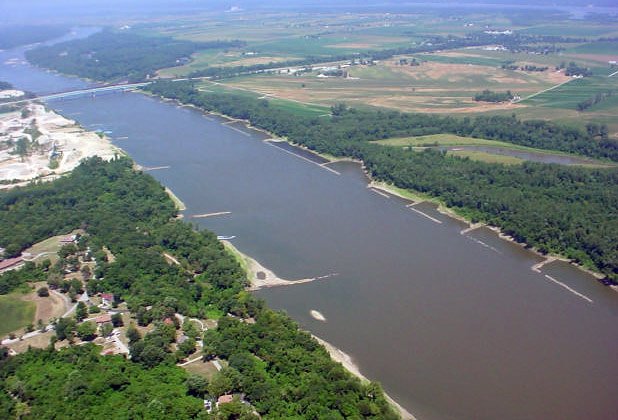
Wing dam safety tips
- Always stay in the channel when on plane.
- Use your GPS or river charts which are available online from US Army Corps of Engineers. They mark out where wing dams are on the river.
- When exploring a wing dam, never approach a wing dam from the upstream side unless you know for sure how much water is over the top of it. Approach from downstream, this way if you do happen to hit the wing dam you are not stuck and you have the current to push you off of it.
- Use extreme caution at night or in windy conditions. The added chop on the water can hide the wing dam.
- If anchoring on the upstream side of the wing dam, be mindful of what is going on around you. The anchor could come loose at any point and you could flow right into the wing dam.

With this sophisticated technology comes price tag. Good units could be had for under $1000 but many of the top end units can go for thousands. The Hummingbird 998c SI is widely regarded as one of the top units on the market and retails for around $2,000 while the 1198 model retails for $2,800. The 998c has a large, 8” screen and can scan to 1,500 feet. The 1198C model has a 10.4” screen and 480 feet of imaging from side to side. However they have a more affordable model, the 798 CI HD, which can be had for $849. It has a 5” screen, but also still comes equipped with Dual Beam Plus technology which enhances resolution and enables anglers to distinguish fish in cover.

Besides Humminbird, Lowrance also has a variety of quality units such as the HDS series with models such as the HDS 5 which run from $650 to the HDS 10 which retails for an affordable $1,300. All HDS models are compatible to have both side imaging and down imaging with Structure-Scan which can be purchased separately for $599. At this writing, Lowrance’s top end unit is the HDS-10 Gen-2 which sells for $2,300. All of these models come equipped with GPS, chart-plotters, and a load of other features to enhance the fish finding experience.
The fishing industry has exploded with technological advancements in the past couple of decades and one of the most important has been side scan sonar. While I have applied it to a specific form of fishing in this article, it is very versatile and can be used in a number of different multi-species fishing applications to help you become a better fisherman and be the key to winning a tournament. Many manufacturers produce units of varying price range. Whether you are on a budget, or strictly a “Lowrance guy”, you can definitely find the perfect unit for you.



